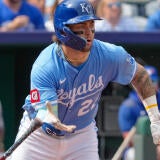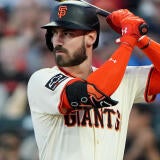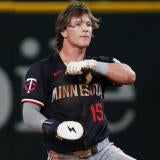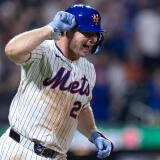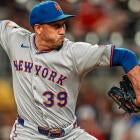Fantasy Baseball: The state of first base position heading into 2026; following 2025 breakouts, busts, more
Kurtz' breakout defined the position in 2025
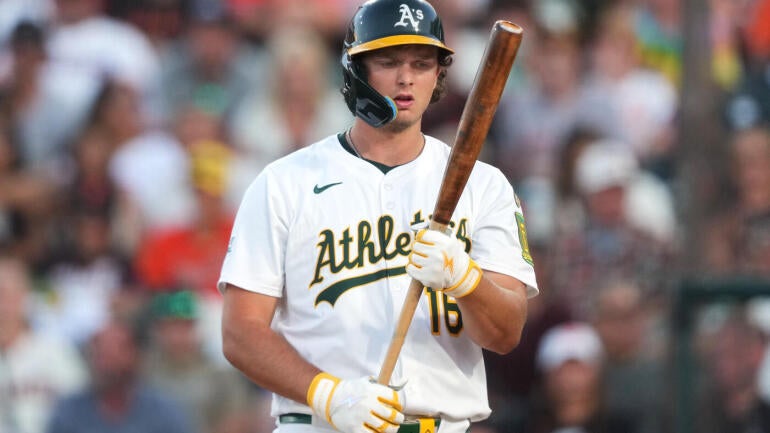
Heading into 2026, first base is in a marginally better position than it was a year ago. And that's almost entirely due to one man: Nick Kurtz.
First basemen as a whole had just a 107 wRC+ in 2024, the lowest mark since at least 2002. In 2025, that bounced back a bit to a 109 mark, though that is still the fourth-lowest mark at the position in that span. The number of legitimate four-category contributors at the position continues to shrink, and what might be most concerning is that the ones who remain are, by and large, on the wrong side of 30 or about to get there.
Among the top 10 finishers at first base in 2025, only Nick Kurtz, Vladimir Guerrero, and Vinnie Pasquantino are younger than 28 (and Pasquantino turns 28 this offseason); raise that bar to 30, and Rafael Devers and Josh Naylor make it, but that still means half of the top 10 are in their 30s. The era of Paul Goldschmidt dominating the position is clearly over, and the Bryce Harper/Freddie Freeman/Matt Olson/Pete Alonso group are at the age where rapid decline, while not expected, wouldn't exactly be surprising.
And we're still waiting for the changing of the guard. Kurtz did his part in 2025 and will be the consensus top option off draft boards in 2026 after hitting .290/.383/.619 as a 22-year-old rookie. Otherwise, we're seeing the results of some changing league-wide trends – better defensive position continues to flatten the positional curve even after the shift was limited, while the universal DH continues to push certain other players off first base who would likely have landed there otherwise – as well as a particularly poor crop of first base prospect outcomes over the past decade.
Looking at the Top 101 prospects lists from BaseballProspectus.com since the 2017, just half of the 28 players listed as first basemen have even gotten to 500 plate appearances in the majors. Allowing for the fact that some of them haven't really had the chance to establish themselves yet, we can just isolate from 2017 through 2023's lists, which sees all but four reaching that 500-PA marker. That's better.
However, just getting to 500 PA isn't what we're looking for; we're looking for impact bats, and that's where the first base prospects of recent years really fall short. Just nine of 16 have a career wRC+ of at least 100 (that's league average), and that number would be even lower without relative breakouts from Spencer Torkelson and Andrew Vaughn this season. Raise that bar to 110 – so, just above the average first baseman in 2025's down environment for the position – and we have just Yordan Alvarez (who hasn't really played 1B in the majors and isn't eligible for 2026 there), Pete Alonso, Triston Casas, Cody Bellinger, and Josh Bell. Bell is no longer more than a late-round flier for Fantasy, and Casas has been pretty good when on the field, but has missed a bunch of time with injuries and hasn't really made an impact outside of the second half of the 2023 season, which leaves us with … Alonso and Bellinger as the true success stories for the position since 2017. You can throw Vladimir Guerrero in there (he came up as a third baseman) if you want to make things look better, but the reality is, there just haven't been a lot of hits among first base prospects lately.
And we're feeling it at the MLB level. Those older stalwarts are still mostly holding it down, though there are warning signs for Harper, Olson, Devers, and Freeman that have knocked them down a peg or two. Kurtz is doing his part, but we need some reinforcements at the position before the bottom truly falls out.
Is that help coming in 2026? Read on for my thoughts on the biggest breakouts from 2025, the biggest rankings risers, some rookies to know, and more. But, spoiler alert: I think it's more likely the position is in worse shape this time next year than the opposite.
2025 First Base Review
- Pete Alonso, NYM: .272 - 87 - 38 - 126 - 1
- Josh Naylor, SEA: .295 - 81 - 20 - 92 - 30
- Cody Bellinger, NYY: .272 - 89 - 29 - 98 - 13
- Rafael Devers, SF: .252 - 99 - 35 - 109 - 1
- Nick Kurtz, ATH: .290 - 90 - 36 - 86 - 2
- Matt Olson, ATL: .272 - 98 - 29 - 95 - 1
- Vladimir Guerrero Jr., TOR: .292 - 96 - 23 - 84 - 6
- Freddie Freeman, LAD: .295 - 81 - 24 - 90 - 6
- Vinnie Pasquantino, KC: .264 - 72 - 32 - 113 - 1
- Michael Busch, CHC: .262 - 78 - 34 - 90 - 4
- Yandy Diaz, TB: .300 - 79 - 25 - 83 - 3
- Tyler Soderstrom, ATH: .276 - 75 - 25 - 93 - 8
Okay, we've gotta talk about Josh Naylor here. He became the slowest player in the Statcast era to steal 30 bases, and it wasn't particularly close – Juan Soto stole his 38 while ranking in the 13th percentile in sprint speed, while Naylor was in the second percentile. Before those two, Kyle Tucker in 2023 was the slowest 30-steal guy, and he was in the 33rd percentile. Naylor was an incredibly opportunistic baserunner, especially after the trade to Seattle, as he stole 19 in 54 games – a near 60-steal pace. Of course, this was also a contract year, and steals have a tendency to spike in contract years – which makes sense, as attempting steals is one thing a player has a lot of control over to boost their perceived value on the market. Does that mean Naylor will go back to being a non-factor for steals if and when he lands with a new team this offseason? There's no guarantee, but if I set the over/under on steals in 2026 at 14.5 for Naylor, I probably wouldn't take the over.
It's not like there was some kind of position-wide speed rush happening, either. His 30 steals were more than double the next best first baseman, and played a big part in why he ranked so highly despite merely pretty good numbers otherwise. That's a good reason to fade Naylor in 2026.
As for the rest of the position, it's pretty much what you expect at this point: Some really strong four-category production at the top end, and then either batting average or power specialists after that. Bryce Harper comes up just short of making this top 12, mostly due to injuries – though it is worth noting that he had a pretty unremarkable season by his standards, which is noteworthy as he approaches his mid-30s.
Biggest Breakout from 2025
Nick Kurtz, Athletics
Kurtz is either going to be one of the four or five best hitters for the next decade or there are going to be a lot of disappointed Fantasy analysts and players. He finished his rookie season with a 1.002 OPS, becoming just the sixth player in MLB history with a 1.000 OPS in at least 450 plate appearances as a rookie. And there aren't a lot of flops on that list: Albert Pujols, Aaron Judge, Ryan Braun, Ted Williams, and … Bernie Carbo? Okay, yeah, there's one flop there, as Carbo would go on to have a .782 OPS over his next five seasons, with just one part-time season where he managed even a .900 OPS the rest of his career.
But even the guys who remained very good hitters mostly took a step back in their second season, too:
- Judge: 1.049 OPS as a rookie; .919 OPS his next season
- Pujols: 1.013 OPS as a rookie; .955 OPS his next season
- Braun: 1.004 OPS as a rookie; .888 OPS his next season
- Williams: 1.045 OPS as a rookie; 1.036 OPS his next season
- Bernie Carbo: 1.004 OPS as a rookie; .677 OPS his next season
All four of them took a step back, though obviously Williams' was marginal. And there's nothing wrong with just being a high-.800s/low-.900s OPS bat. But if Kurtz gets pushed into the first-round range in 2026 drafts (which seems likely at this point), it doesn't leave much margin for error. If he's just Matt Olson next season, that's still a great player. But it would make Kurtz a pretty big disappointment at that price.
And there is risk here. He has prodigious skills, but if his second-half strikeout rate improvement doesn't stick, there's obvious batting average risk here for a guy who had a 31% strikeout rate and .255 expected batting average overall. His home park will help, but Kurtz has legit swing-and-miss issues that could be exposed. He'll still hit for a bunch of power, but expecting Kurtz' rookie season top-line numbers to just represent his base-line moving forward might be a mistake.
Biggest Bust from 2025
Burger was being drafted as a top-10 first baseman entering 2025. I was way out on him at that price, and it should serve as a cautionary tale moving forward. Burger is a very good power hitter, but that's all he does well. Unlike many other power hitters, Burger rarely draws a walk, and when you combine that with well below average defense (at either corner spot) and nonexistent baserunning value, and it left him with a very slim margin for error. On a Marlins team desperate for hitting, that never really cost him playing time, but it became an issue on a Rangers team with playoff aspirations and viable alternatives. When Burger is locked in, he's a very useful player in real life despite his limitations, but he's also streaky, and it's untenable to play him on a good team when things aren't going well. He very well may end up starting somewhere and put up another 30-homer season in 2026, but this is not a profile you should be chasing when it costs close to a top-100 pick.
If you're looking for a player who could be in a similar spot in 2026, Eugenio Suarez comes to mind (albeit at a different position). He'll walk more than Burger and figures to get a big enough contract this offseason that his team will feel obliged to play him even if things go sideways. But he's a similar one-dimensional slugger whose value really depends on being an outlier power hitter.
Biggest rankings movers from 2025 to 2026
Up: Nick Kurtz, Athletics; Tyler Soderstrom, Athletics; Spencer Torkelson, Tigers
I thought I had Soderstrom pegged: He was an intriguing hitting prospect, but not one who would likely matter for Fantasy once he lost catcher eligibility. He definitely exceeded expectations in 2025, and with an xwOBA of .352 compared to his actual mark of .354, it seems sustainable. He fizzed out a bit after a hot start, slumping in May and June, but ended up with an .853 OPS in the second half. I always like to see how our breakouts adjust to the adjustments, and Soderstrom did what we wanted to see.
Torkelson has a bit of that Jake Burger thing going on for him. He's a lot more willing to take a walk, but as we've seen in his career, his playing time is never assured when he goes into slumps. The power here is legit, but playing half his games in Detroit makes it an uphill climb at times, and he's someone I'm more comfortable with as a corner infielder when I need power specifically than someone I want to rely on as a cornerstone of my lineup.
Down: Christian Walker, Astros; Jake Burger, Rangers; Triston Casas, Red Sox
Admit it: You didn't realize Walker nearly got to 30 homers and 90 RBI, did you? In fairness, Walker was basically unplayably terrible for the first three months of the season, entering July with a .223/.286/.366 line. But he more or less looked like himself for the final three months of the season, hitting 15 homers with an .800 OPS in the second half of the season. That's not enough to make Walker a viable starting first baseman again heading into his age-35 season, but I do think you need to make sure you don't forget about him for your corner infield spot for what should be some very cheap power.
As for Casas … I dunno. He was bad before he got hurt, but it was only 29 games. But he also hasn't been particularly good in his MLB career, certainly not since the second half breakout in 2023, at least. There is big power potential here, and a move away from Fenway Park (one of the toughest parks for left-handed power in the game) probably wouldn't be a bad thing for him. But at this point, you have to view him as just a late-round sleeper, I think.
Offseason preview
Who needs an upgrade most?
That's not a small number. Some of those will be filled either by incumbents re-signing or possible prospect promotions, but some of these teams are likely just going to continue to have weak first base spots. For a team like the Marlins or Pirates who hope to take a step toward playoff contention this season, clearing the low bar of getting at least league-average production from the first base spot should be a big priority. We'll see if it is.
Top impending free agents
- Pete Alonso
- Cody Bellinger*
- Josh Naylor
- Rhys Hoskins**
- Paul Goldschmidt
- Josh Bell
*$25 million player option with a $5 million buyout
**$18 million mutual option with a $4 million buyout
There are some moving pieces here, but Alonso has at least already announced he will be opting out and heading into free agency. You have to think the Mets are heavy favorites to re-sign him, and I don't expect it to take nearly as long to come to an agreement as it did last offseason.
Bellinger seems all but certain to opt out of the final year of his deal, though that hasn't been confirmed yet – but could be as soon as the Yankees season ends. He brings athleticism and defensive versatility few other first baseman can match, which should lead to a strong market for his services now that we have a few years of above-average production to go on. But leaving Yankee Stadium wouldn't exactly be a good thing for this lefty's production, so let's hope he returns.
Naylor is the other big bat remaining, though I could see him dealing with a protracted negotiation as he tries to land what will likely be his one and only big free agent contract. He's a fine hitter, and an especially adept run-producer, but he's also limited to 1B and isn't likely to bring much value to the table beyond his bat, so it'll be a tough market. The rest of these guys seem likely to settle for one-year contracts as fill-ins for teams who don't want to take a zero at the position but also don't want to make a big investment. Hoskins still seems like he has some juice left, but you're still mostly just hoping for slightly above average production from him at this point.
Trade candidates
- Yandy Diaz, Rays
- Michael Busch, Cubs
- Spencer Steer, Reds
- Triston Casas, Red Sox
- Ryan Mountcastle, Orioles
There's a lot of speculation here, obviously, but we can make some educated guesses. The Rays don't want to spend money. The Red Sox, Reds, Orioles, and Cubs have some log jams they could clear by moving on from "good enough" options at the cold corner. I'd say Busch is the least likely to be traded, but if the Cubs don't view Moises Ballesteros as a long-term option behind the plate, they probably need to move him to first base at some point. Of course, he could also be traded if the team wants to upgrade their major-league roster without losing any 2025 contributors.
Top 2026 rookies to know
- Bryce Eldridge, Giants
- Tre' Morgan, Rays
You could also add names like Xavier Isaac (Rays), Charlie Condon (Rockies), Cam Collier (Reds), Jonathan Long (Cubs), Ryan Clifford (Mets), or Josue Briceno (Tigers), all of whom are listed at other positions or don't quite crack global top-100 lists. But there aren't a ton of true first base prospects in the high part of most rankings lists to begin with, and outside of Eldridge, nobody seems poised to make an immediate impact right now. The offseason could change that, of course, but don't expect the savior at first base to come from the minors (at least not again, Nick Kurtz).
I do want to pause and focus on Eldridge for a second, because he is someone you want to have on your radars. He got a cup of coffee at the end of the season for the Giants and predictably struggled – he was a 20-year-old just two years removed from being drafted who was playing through a wrist injury that ultimately required surgery to remove a bone spur after the end of the season. This is one of those situations where, if Eldridge had just spent the whole season toiling away in the minors (where he had 25 homers in 102 games and had a 120 wRC+ despite being one of the youngest players at both Double-A and Triple-A, he would enter 2026 with a ton of hype as he battled to make the roster in Spring Training. Instead he'll enter the spring as the presumed starter at first base coming off an MLB cameo where he struggled mightily, which should tamp down the hype.
But make no mistake: Eldridge is in the same tier of prospect Kurtz was before he made his debut and is still very much the kind of player you need to be excited about. Don't let his very brief struggles scare you off.


